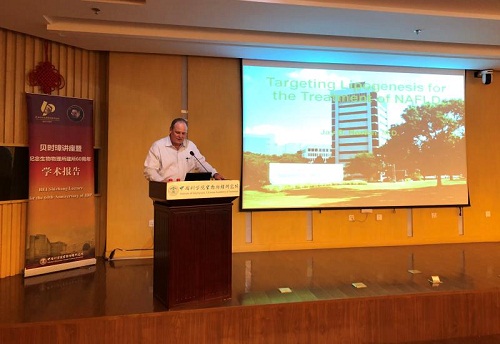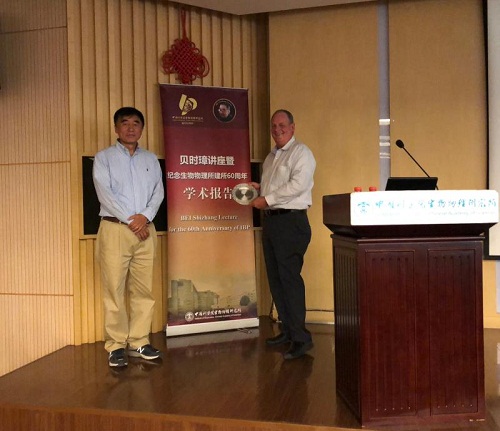On Aug. 23th, 2018, Prof. Jay D. Horton, Professor & Director of the Center for Human Nutrition, University of Texas Southwestern Medical Center at Dallas, visited Institute of Biophysics, CAS, at the invitation of Professor Pingsheng Liu of the National Key Laboratory of Biomacromolecules and gave a lecture entitled “Targeting Lipogenesis for the Treatment of NAFLD”.
Prof. Jay D. Horton has an interest in conditions that lead to steatosis and obesity. A major focus of the laboratory is to determine how the transcriptional regulators of cholesterol metabolism contribute to the development of steatosis in various disease processes such as diabetes, obesity, and beta-oxidation defects. A second area of investigation centers on determining the function of PCSK9, a protein that is involved in determining plasma LDL cholesterol levels through its ability to post-transcriptionally regulate the expression of the LDL receptor in liver.
Non-alcoholic fatty liver disease (NAFLD) encompasses a disease spectrum ranging from simple triglyceride accumulation in hepatocytes (hepatic steatosis) to hepatic steatosis with inflammation (steatohepatitis), fibrosis, and cirrhosis. NAFLD is the most frequent cause of abnormal liver function tests (LFTs) in the U.S. and is strongly associated with insulin resistance and the metabolic syndrome. One important underlying metabolic change associated with insulin resistance is elevated rates of fatty acid synthesis in liver. Synthesis of fatty acids in liver is regulated independently by insulin and glucose. Insulin’s ability to activate lipogenesis is transcriptionally mediated by the transcription factor, sterol regulatory element-binding protein-1c (SREBP-1c). Insulin signaling induces SREBP-1c expression in liver. SREBP-1c then activates all genes required for fatty acid synthesis. In insulin resistant states, hyperinsulinemia leads to excessive SREBP-1c activation, increased fatty acid synthesis, and excessive triglyceride accumulation in liver.
In the presentation, Prof. Jay D. Hortondescribed additional post-transcriptional mechanisms that regulate lipogenesis in liver and strategies to inhibit this pathway for the treatment of NAFLD. His lab found that Inhibition of acetyl-CoA carboxylase (ACC1) and (ACC2), enzymes that produce malonyl-CoA for fatty acid synthesis, resulted in decreased polyunsaturated fatty acid (PUFA) concentrations in liver due to reduced malonyl-CoA, which is required for elongation of essential fatty acids. Then they found another protein (MIG12) that also plays a role in the regulation of lipogenesis will form a big complex with ACC, FAS, and S14 on ER that surround lipid droplets and then regulate the FA/TG synthesis pathway. This finding will provide a new perspective to the treatment of NAFLD.
This report won warm applaus and enthusiastical questions. At the end of the report, Prof.Pingsheng Liu gave the ShizhangBei Lecture souvenir as a gift to Professor Jay D. Horton.


